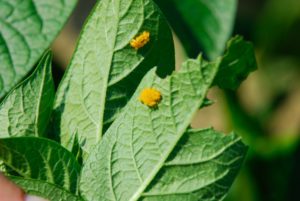Sep 22, 2020Non-neonicotinoids helpful in combating Colorado potato beetle
When neonicotinoids entered the market 25 years ago, they were a highly effective novel mode of action that quickly became a cornerstone for managing Colorado potato beetle.
That cornerstone, although solid in many agronomic situations, offers less support when the driver insect is Colorado potato beetle.

“There have been some reports of neonicotinoids not working well in the eastern part of the U.S.,” said Kiran Shetty, Ph.D., Syngenta technical development lead for potatoes. “There are also reports of second-generation beetles not being effectively controlled by neonicotinoids.
“In that case a product like Minecto Pro, a non-neonicotinoid foliar insecticide, fits really well because you can clean up the second generation that comes up during the course of the season while maintaining a good resistance management strategy.”
Colorado potato beetle can quickly defoliate an entire potato crop when untreated or ineffectively controlled, making them one of the most economically damaging pests in potatoes. Both adults and larvae feed on potato foliage, so it’s imperative that growers effectively treat this leaf-feeding pest at all life stages. However, controlling Colorado potato beetle is an uphill battle due to the insect’s high fertility — females can lay up to 350 eggs in their adult life — and its ability to quickly develop resistance.
Shetty reiterated the Insecticide Resistance Action Committee’s recommendation to growers that if they begin the season with a neonicotinoid seed treatment or soil application, they should refrain from using another neonic application for the remainder of the season to prevent resistance development in pests.
“I first started using (Minecto Pro) last year, which was by far the worst beetle year that I’ve ever seen,” said Hazen Palmer, independent crop consultant. “We didn’t even use the highest rate of spray, and it smoked everything out from all life stages.”
Specific crop loss and reduced yield solely attributed to Colorado potato beetle can be difficult to identify due to an array of harmful pests also causing potential crop damage. However, Michigan potato growers illustrated the extent of the issue when they reported spending $6.8 million in 1994 to control the pest and still experienced a 14% loss of overall potato crop value.
Several factors determine insect population and consequent insect behaviors, generally driven by local conditions and agronomic practices. Shetty says insect management practices must be tailored to the location, crop and insect history and certainly changing dynamics of insecticide resistance. Strategies to combat resistance include rotating chemistries, time and method of application and adopting steps to prevent or deter feeding of the insects.
Shetty encourages potato growers to develop a proactive, integrated pest management program with non-neonicotinoid insecticides to go into the season with confidence, particularly if a neonicotinoid is used during planting.
“Diamides that contain the active ingredient cyantraniliprole, like Minecto Pro, provide stronger control than first generation diamides and are an exceptional alternative to foliar neonicotinoid insecticides,” said Shetty. “They are an excellent tool to incorporate in an insect management program for potatoes.”

Top photo: Syngenta







